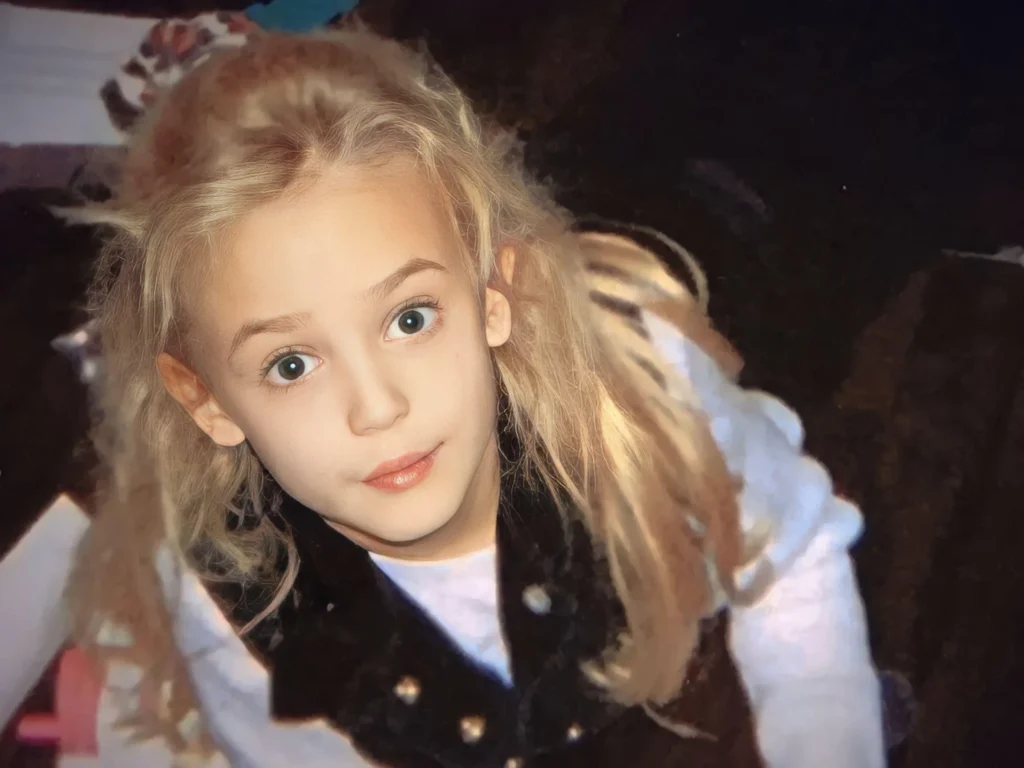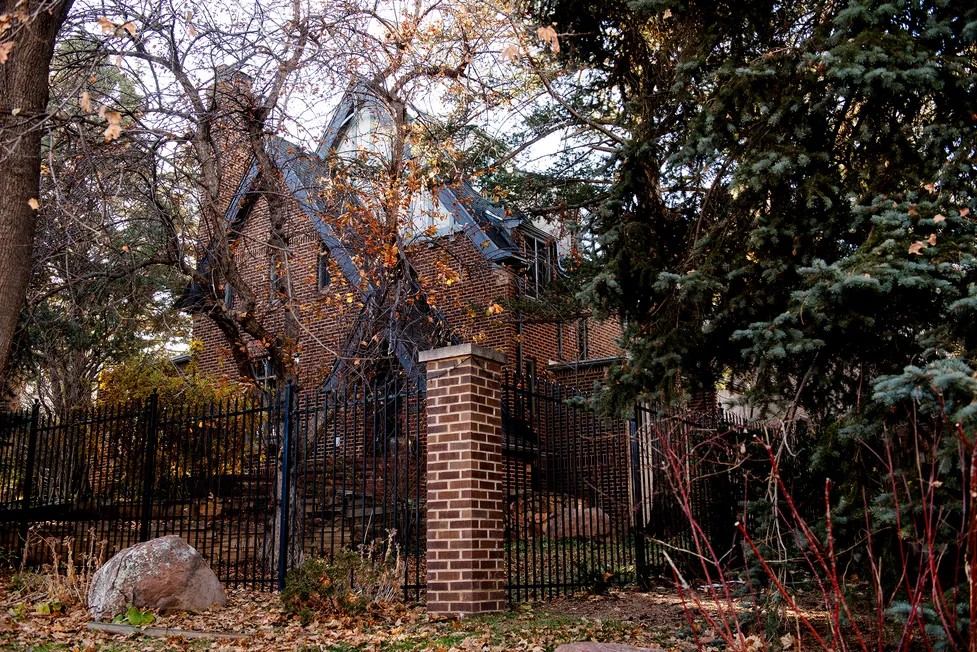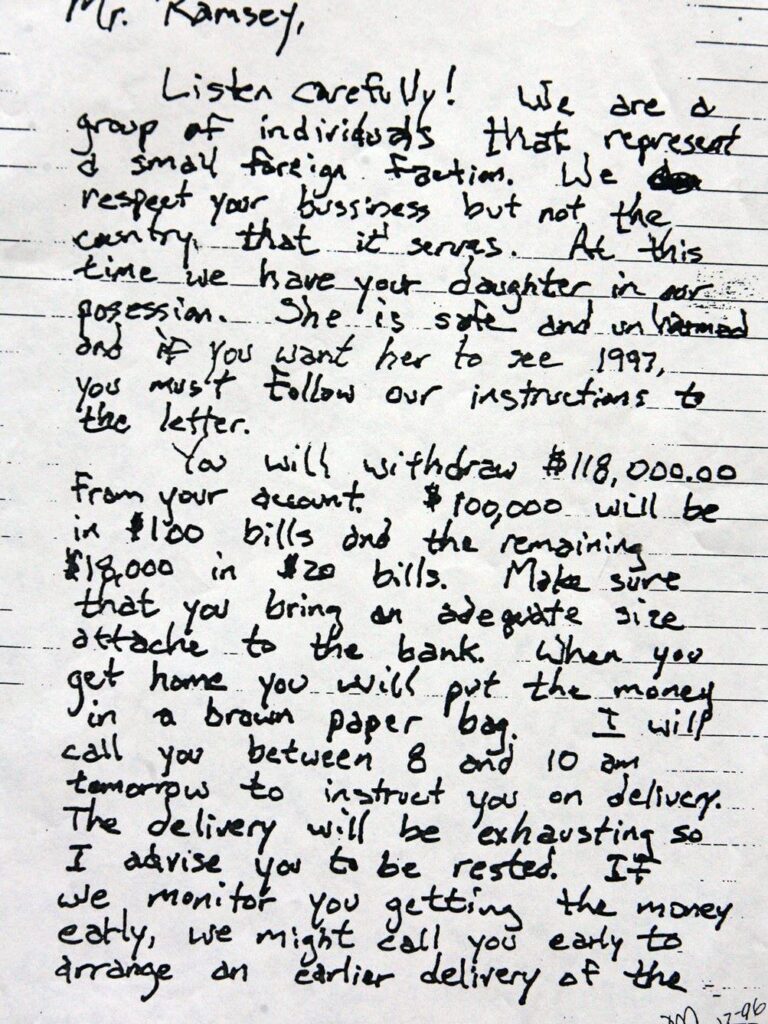
The Ramsey house on 15th Street looked like every other upscale home tucked into the snowy corners of Boulder, Colorado. The walkway was lined with flickering lights. A wreath hung on the front door. Inside, the living room smelled of pine and pastry. It was Christmas night, 1996.
JonBenét Patricia Ramsey had just turned six that August. She wore a black velvet outfit with a white collar and red bow. Earlier that evening, the Ramseys had attended a party at their friends’ house, Fleet and Priscilla White. Some photos from that night would later resurface: JonBenét on the floor, laughing, her blonde hair tied back in a neat ponytail. She looked like a child having a normal holiday. No one at the party noticed anything unusual.
Patsy Ramsey had woken up early to get ready for a family trip to Michigan. They were flying out that morning. She came downstairs before 6:00 AM, walked toward the kitchen, and stopped cold.
There was a note on the back staircase.
The handwriting was shaky but deliberate. The message was long. It began with: “Mr. Ramsey, listen carefully! We are a group of individuals that represent a small foreign faction…”
Patsy ran back upstairs and screamed for her husband.
Then she called 911.

The 5:52 AM Call & the Basement Discovery
The call came in at 5:52 AM. Patsy Ramsey’s voice was high, frantic. She told the dispatcher her daughter was missing. That there was a note. That someone had kidnapped JonBenét.
Dispatcher Kimberly Archuleta asked her to stay on the line, but Patsy hung up. In the background, some claimed they heard John Ramsey and family friend Fleet White talking. Others later speculated that Burke’s voice was there too. That part was never confirmed.
Boulder police arrived within minutes. Officer Rick French searched the house room by room. He paused outside a door in the basement. It was latched shut. He did not open it.
The ransom note instructed the Ramseys to wait for a phone call between 8:00 and 10:00 AM. It said JonBenét would be returned safely if the instructions were followed. But the family did not wait silently. They called friends. Invited them over. Moved through the house. They made coffee. They made noise.
Detective Linda Arndt was the only officer left in the house by midmorning. The Ramseys had been told to do a search of the house, just in case. John went straight to the basement. Fleet White followed him.
At 1:05 PM, John Ramsey came up the stairs carrying JonBenét’s body.
She was wearing a white nightgown. Her mouth had been covered with duct tape. Her wrists were bound with white cord. Another cord had been tied around her neck and looped through a broken paintbrush handle. That garrote had been twisted tight.
John placed her body on the floor near the Christmas tree. Patsy collapsed beside her.
Detective Arndt later said she felt like she was the only person in the room without an alibi.
The Ransom Note
It was found on the back staircase, just off the kitchen. Three pages, handwritten. Not torn out in a rush, but neatly removed from a legal pad that belonged to Patsy Ramsey. The pen used had also come from the house.
The note began with a flourish: “Mr. Ramsey, listen carefully!” Then it spun into something stranger.
The author claimed to represent “a small foreign faction.” They wrote that JonBenét had been kidnapped and warned the family not to call the police. They demanded exactly $118,000 in ransom — $100,000 in $100 bills and $18,000 in $20s. That sum happened to match John Ramsey’s Christmas bonus, almost to the dollar. That detail had not been made public.
The language was inconsistent. Parts of it were formal, even theatrical — phrases like “You stand a 99% chance of killing your daughter if you try to outsmart us” — while others bordered on absurd: “Don’t try to grow a brain, John.” The note referenced movies like Dirty Harry and Speed, either intentionally or unconsciously.
The note ended with the word “Victory!” followed by the letters S.B.T.C.. No one ever figured out what that meant. Theories ranged from military jargon to religious acronyms to complete fabrication.
What stood out most was the length. Ransom notes are rarely more than a few lines. This one read more like a screenplay. FBI profilers called it “overwritten.” Several said it looked staged. Former detective James Kolar noted that writing such a note in the house, after committing a violent crime, would be a strange and risky decision for any outsider.
Handwriting experts analyzed it. Some said the style shared traits with Patsy Ramsey’s, especially in the curvature of certain letters. Others said it wasn’t close enough to confirm anything. The official conclusion remained inconclusive.
No fingerprints were found on the paper. No foreign DNA. Only what already belonged in the house.
Investigators believed whoever wrote that note wanted it to be found. They believed it was written after JonBenét was already dead. And they believed it was meant to change the story.

The Body in the Basement
The door was there the whole time.
When Officer Rick French first swept through the Ramsey house on the morning of December 26, he reached the basement and paused in front of a white wooden door. It had a simple latch on the inside. He tried the handle. It was locked. He moved on.
It wasn’t until hours later that John Ramsey opened it.
At 1:05 PM, after Boulder detective Linda Arndt asked the family to check the house again, John and Fleet White went downstairs. John walked straight to that door, unlatched it, and disappeared into the dark.
Moments later, he screamed.
He carried JonBenét’s body up the stairs in his arms. She was limp, wrapped in a white blanket. Her wrists had been tied with white cord. A piece of duct tape had been pressed over her mouth. There was a garrote around her neck—made from a nylon cord tied to the handle of one of Patsy’s broken paintbrushes.
He laid her on the floor beside the Christmas tree.
Patsy collapsed beside her and began to wail.
The room where she had been found was a small, windowless storage space often referred to as the “wine cellar,” though it held no wine. It was cold, dusty, and unfinished. There was a small basement window nearby, cracked open, with an old suitcase positioned underneath it. Spiderwebs still clung to the corners of the glass. Police never confirmed whether anyone had entered or exited that way.
Crime scene preservation had already broken down by then. Friends and family had been walking through the house for hours. JonBenét’s body had been moved. The blanket and tape had been touched. The scene was contaminated.
Detective Arndt later testified that the moment John brought the body upstairs, she reached for her service weapon. She said she counted the bullets in her head.

What the Autopsy Found
JonBenét’s autopsy began on the morning of December 27, 1996, just hours after her body was recovered from the basement floor. Dr. John Meyer, the Boulder County Coroner, examined her remains at the local morgue. What he found raised more questions than it answered.
The official cause of death was listed as asphyxia by strangulation associated with craniocerebral trauma. Both injuries could have been fatal. A blow to the head had fractured her skull nearly eight and a half inches across. There was no visible bleeding on the outside, but inside, there was a massive hematoma.
The garrote tied around her neck had left a deep furrow mark. It had been twisted tight using a broken wooden stick from one of Patsy Ramsey’s paintbrushes. Nylon cord had been looped around her neck, then around the stick, and pulled. The knot was complex. It took effort to make.
There were abrasions on her back and legs. A small spot of blood was found in her underwear. Internally, the autopsy noted injuries consistent with sexual trauma. No semen was recovered. No evidence of rape in the traditional sense. But something had caused the wounds. Investigators believed it may have been inflicted using an object.
She had undigested pineapple in her stomach. A bowl of pineapple mixed with milk had been found in the kitchen, left out on the table. Burke Ramsey’s fingerprints were on the bowl. Patsy’s prints were on the spoon. Neither parent could remember setting it out. They said JonBenét hadn’t eaten pineapple that night.
Toxicology results came back clean. No drugs, no sedatives, no alcohol.
Time of death could not be precisely determined. Based on rigor mortis and body temperature, most estimates placed it somewhere between 10:00 PM and 6:00 AM. That window covered nearly the entire night.
There was no dust or debris on the soles of her feet, suggesting she had been carried to the basement. There were no signs of struggle in her bedroom. No evidence she had ever left the house.
The autopsy answered what had killed her. It did not answer who had done it, or why.
Everyone Lawyered Up
The Ramseys called a press conference before they sat down with detectives.
Within days of JonBenét’s death, the family hired separate attorneys. John brought in Bryan Morgan, a well-known criminal defense lawyer from Denver. Patsy hired Patrick Burke. By the end of the week, they had added a media consultant, a handwriting expert, and a former FBI profiler. They were building a team, not just a defense.
Police noticed early that the Ramseys were cautious. They stopped giving interviews to investigators. They declined polygraph tests offered by the Boulder PD. When the police asked to meet with them separately, with no lawyers present, they said no.
Instead, the Ramseys went on CNN.
Ten days after their daughter was found dead, John and Patsy Ramsey sat down for a televised interview with CNN’s Brian Cabell. The lights were bright. The questions were soft. John appeared somber. Patsy looked exhausted, her voice shaky.
Then she said something that stood out.
“There is a killer on the loose,” she told viewers. “I don’t know who it is. I don’t know if it’s a he or a she. But if I were a resident of Boulder, I would tell my friends to keep—keep your babies close to you. There’s someone out there.”
Two weeks later, during another interview, she said something else.
“There are two people who know what happened,” she said.
John turned and looked at her.
She paused, then added, “The person who did it… and someone they confided in.”
That explanation did not sit well with the public. The phrasing felt strange. As if the idea had come out too fast. Like it hadn’t been rehearsed. Some viewers called it a slip. Others called it panic. John never addressed the moment publicly.
The Ramseys released a book. They appeared on Larry King Live. They continued to decline police interviews. When the Boulder DA asked for one-on-one conversations, they refused unless all questions were submitted in advance.
Police felt stonewalled. The Ramseys said they were protecting themselves.
Neither side trusted the other.
The Boulder Police vs the DA
From the beginning, the case fractured not just the family, but the system.
By early 1997, tension had set in between the Boulder Police Department and the District Attorney’s office. Investigators believed the Ramseys were hiding something. They wanted formal interviews. They wanted search warrants. They wanted leverage. The DA’s office resisted.
Boulder’s DA at the time, Alex Hunter, kept the case close. Too close, according to some. Instead of pressing the family, the DA’s office urged caution. They emphasized public perception. They stressed the need for more evidence. Detectives grew frustrated. Some began leaking to the press.
In June 1998, the police turned over a 160-page case summary to the DA and recommended that the grand jury hear the evidence. The DA agreed.
That October, a grand jury was convened in secret. For over a year, it heard testimony. Witnesses were brought in privately. The public knew little about the proceedings. Then, in 1999, the jury quietly wrapped up its work. No charges were filed. No indictments were announced.
What no one knew then was that the jury had voted to indict both John and Patsy Ramsey.
They had signed an official document accusing the couple of child abuse resulting in death, and of helping someone avoid prosecution. The charges were sealed. The DA never followed through.
Alex Hunter later said the evidence was too weak to move forward. That a jury might have believed a crime occurred, but not that it could be proven who did it. The Ramseys were never told about the vote.
The sealed indictment remained hidden for fourteen years.
In 2013, after a public records lawsuit, a judge ordered it released. It showed that the grand jury believed the Ramseys had placed their daughter in a situation that led to her death—and then tried to cover it up.
The document bore the signatures of both jurors and the prosecutor. It had been filed but never acted on.
The case had been built. Then quietly closed.
The Brother, the Lawsuit, and the Silence
For nearly two decades, Burke Ramsey was mostly a shadow in the case. He was nine years old when his sister died. Police initially interviewed him the day after the body was found. A child psychologist led the session. Burke said he had slept through the night. He said he heard nothing.
Later recordings showed him quiet, smiling at strange moments, shifting in his chair. Some viewers found it unsettling. Others saw it as trauma.
In 2016, Burke agreed to an interview with Dr. Phil. He was 29 years old. It was his first major appearance since the case broke. He spoke in slow, measured sentences. When Dr. Phil asked about public suspicion, Burke said he believed it was “people looking for answers.” He denied involvement.
That same year, CBS aired a documentary called The Case of: JonBenét Ramsey. It featured former FBI agents, forensic pathologists, and criminal profilers. The panel argued that JonBenét’s death had been caused by a blow to the head—possibly from a flashlight—and that the garrote had been added later to stage a kidnapping. They suggested that Burke could have struck her during an argument over pineapple. That segment aired to millions.
Burke sued CBS for $750 million in defamation.
The lawsuit claimed the documentary was “manufactured fiction.” It stated that experts had been selectively edited and that CBS had pushed a narrative for ratings. CBS eventually settled out of court. The amount was never disclosed. The apology never came.
Burke has since disappeared from public life again. He never retracted his interview. He never spoke about his sister again.
A Cold Case That Keeps Moving
In 2008, new DNA testing changed the case again. A lab in Michigan re-analyzed the evidence. They found “touch DNA” on JonBenét’s long johns—a small sample of skin cells from an unknown male. The Colorado DA, Mary Lacy, responded quickly. She formally cleared the Ramsey family. She said they were no longer under suspicion.
That decision sparked backlash. The Boulder Police Department said they had not been consulted. Independent experts said the DNA could have come from contaminated clothing, or even from a factory worker. The sample was too small to be conclusive.
In 2016, the case returned to headlines after the CBS special. Public pressure mounted again. New forensic labs offered advanced testing. But the Boulder PD did not accept outside help.
In 2021, the Colorado Bureau of Investigation confirmed that more advanced DNA testing had been requested. In 2022, they said they were working with private labs to assess the remaining evidence. No new results were shared. No suspect was named. No charges were filed.
The last public statement from Boulder police came on the case’s 25th anniversary. It said the investigation had included over 21,000 tips, 1,000 interviews, and analysis of over 1,500 pieces of evidence. It said the case remained open. But nothing else followed.
The family has called for independent testing using genealogical databases—the same kind used to find the Golden State Killer. The police have declined.
The case is still classified as a homicide. The evidence is still in storage.
So What Happened That Night?
No one ever found JonBenét Ramsey’s killer.
Every theory has gaps. Every explanation has one detail that doesn’t sit right. The intruder theory hinges on the broken basement window and the suitcase below it—but the spiderwebs on the glass were undisturbed. The stun gun theory suggested a predator attacked her in her sleep—but no neighbors heard anything. There were no signs of forced entry. No footprints in the snow.
The family theory has its own problems. It suggests a cover-up under pressure. A frantic response to an accident. But the evidence never tied directly to John, Patsy, or Burke. The DNA on her clothing still belongs to someone else.
The ransom note remains the most confusing piece. Too long. Too strange. Too personal.
Patsy Ramsey died of ovarian cancer in 2006. She never changed her story. John Ramsey still gives interviews. He still says the killer is out there. Burke lives privately. He has never been charged. No one ever has.
JonBenét was six years old. She died in the home where she had opened her Christmas presents. Her room was untouched. Her name became national shorthand for media frenzy, child beauty pageants, and botched justice.
The front door of the Ramsey house was painted over years ago. The family moved out. New owners redecorated. But somewhere, in a cold vault in Boulder, the case file still sits open.
And it still doesn’t have an ending.





